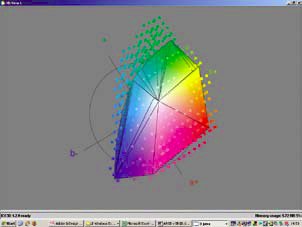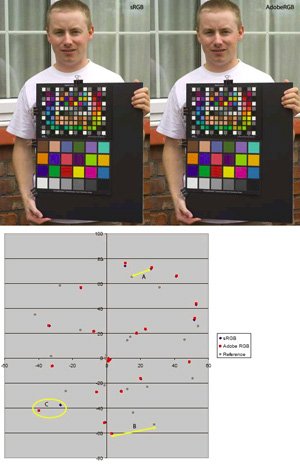articles/Photoshop/adobergb1998-page1
Adobe (RGB)1998 versus sRGB - part 1 of 1
by Mike McNamee Published 01/11/2005

DOES IT REALLY MATTER?
Mike McNamee answers the question once and for all!
The debate on choice of RGB working space goes on and on and so perhaps it is timely to put the thing to rest or at least give you the tools to make the decision.
For the majority of photographers it does not matter whether you use ARGB or sRGB. What matters is what you do with a file when you get it to Photoshop! A file is "tagged" with a profile (also called an "embedded profile") when that option is activated in the device that creates and saves the digital file. The "device" is most frequently a camera or scanner but can also be a software program such as Photoshop or PhotoPaint.
The best analogy for a tagged file is that it is like a letter that is written in (say) German, that you post to a friend. You know your friend is not a German speaker so you include, in the envelope, a German dictionary, ie you tag the letter with a dictionary (profile). Now when your non-German speaking friend gets the letter he can work out what you want to say because he can use the dictionary to translate the words. If you send the letter without a dictionary (ie untagged) and your friend makes an incorrect guess that it is written in Dutch he will mistranslate most, but not all of it, (some of the words are actually quite similar). If however the letter arrives and your friend guesses (correctly) that the letter is in German and pulls the correct dictionary off the shelf (he assigns it) he can translate with complete accuracy. So, if a file arrives tagged, you obey or honour the profile. If it arrives untagged you have to guess the workspace profile (the language) and assign the correct profile.
Now for the sneaky bit!
Most unprofiled printers reduce the saturation of the colours in the image. By way of example, the Kodak 1400 reduced the saturation by an average of 8%, ranging from 2% to 20% around the gamut. This is quite typical. If you change an image from the smaller sRGB gamut to the larger ARGB gamut you boost the saturation by about 7% in the mid-ranged skin tones. So if the photographer unknowingly boosts the saturation by mishandling the profiles but then prints out on an un-profiled printer, he gets a result in which the saturation is correct. He then tells all his mates what he does and how he does it and spreads the evil word. However some of his mates also send their images to the local lab to be printed and the lab plays by the colour management rules and sends back accurate, but unsaturated prints. Colour management (and /or the lab) then gets a bad name!
ARGB is Bigger than sRGB
It is often said that ARGB is better than sRGB because the gamut is bigger (for the record sRGB has a volume of 902,900Lab3 units Adobe RGB has a volume of 1,277,530Lab3 units). Well it has a greater volume by some 40% but much of that includes colours that cannot be made by a printer. Gamut volumes for printers range from around 450,000 units (for matte papers) to 800,000 (for gloss papers). If you examine the gamuts in detail what you see is that you can make slightly richer cyans from ARGB but other differences are slight. For a real-world practical test we took a RAW file and processed it out to sRGB and ARGB and then printed it from each version by passing the same sheet of paper through the printer twice. We then measured the colour patches and plotted the differences between the colours from each pro- file. The printed images look the same and measure almost identically. The pure cyan measured differently but the difference was quite subtle in these, calibrated, prints. What this exercise told us is that differences between one printer and another or between a profiled and unprofiled printer totally swamp any differences between the choice of Adobe RGB or sRGB. No doubt many wise heads will be nodding and muttering - "well we always thought

"Do not adjust your monitor to match a printer output as this is bad practice - it is no substitute for device profiling."
Professional Image Workflows, Best Practice Guidelines - a draft paper by the Institute of Quality Assurance, 2005
Why does it go pear-shaped?
Things go horribly wrong for all sorts of reasons, but here are a few man-traps to avoid.
1. Do not match your monitor to your print. This is really asking for trouble! You will get away with it some of the time, providing you don't send modified images to an outside laboratory.
2. If you send an image to a lab tagged with your own profile (say off your scanner), make sure that they understand that you want them to honour this profile.
3. If your lab asks you for an untagged image find another lab - one that knows what they are doing.
4. Keep RAW files as your source images as you can change the profile at any time. If you have to convert to some goofy profile to shut the lab up send them copy files as you do not want your archive files with a profile that nobody else uses.
"All image editing (Automated, Manual and profile-to-profile conversions) should be kept to a minimum, due to the potential to erode data, much of which may remain invisible on a monitor."
Professional Image Workflows, Best Practice Guidelines - a draft paper by the Institute of Quality Assurance, 2005
You are currently on page 1 Contact Mike McNamee
1st Published 01/11/2005
last update 09/12/2022 14:50:56
More Photoshop Articles
There are 0 days to get ready for The Society of Photographers Convention and Trade Show at The Novotel London West, Hammersmith ...
which starts on Wednesday 15th January 2025





